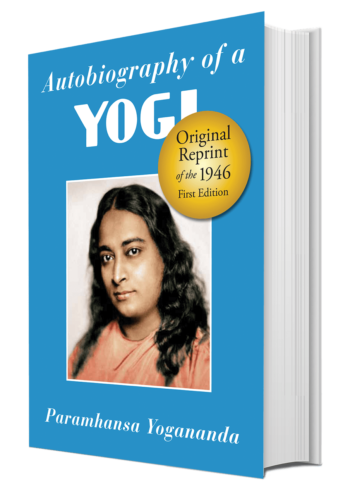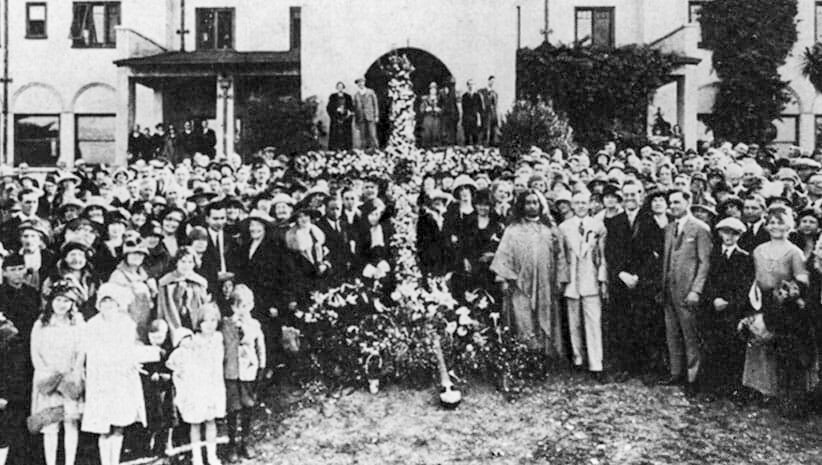
Our reading today is about the mystery of the avatar, and of course explaining it is way above my pay grade.
The majority of people in the world don’t understand the avatar. They have no respect for the idea, and it shouldn’t come as a surprise, since it takes the familiar world of the physical senses and turns it upside down.
And while Paramhansa Yogananda and Swami Kriyananda have done a marvelous job of explaining the avatar, the problem is that it cannot be truly understood with the rational mind.
St. John says, “And the Word was made flesh, and dwelt among us, and we beheld his glory, the glory as of the only begotten of the Father, full of grace and truth.” (John 1: 14)
The key to understanding the avatar is grace. Because we can only really begin to understand these great world saviors by having an inner mystical revelation that makes the incomprehensible real to us.
And, having understood the importance of the avatar, we also need to understand that each of the avatars comes with his own crew.
In a very deep and real sense, I consider myself part of the crew that came with Paramhansa Yogananda. I came specifically with Swami Kriyananda, who has his own team that comes with him whenever he is born to help Master with his mission.
I remember joking with Swamiji, “The next time you’re going to incarnate, I’m probably going to come with you – and could we choose a higher age?”
I said, “Must we always come into these chaotic times of transition on the planet, where nothing about this world is congenial to our spirit? And can’t we just wait for a higher age?”
Swami’s answer was interesting. “First,” he said, “no matter how high the age, it’s still the material plane. It’s not God-realization.”
The astral world is said to be an enjoyable place – I like to think of it as being like a vacation in Hawaii. But the problem with being born in the astral world, or returning to this world during the highest age, is that the incentive for God-realization is less, because the atmosphere is so congenial.
So, really, what difference does it make where we’re born, or when? We might not prefer to be born in an age where we’ll have to struggle, but if our goal is freedom, why would we complain?
Swami shrugged – he said, “Satya Yuga, Kali Yuga, it’s not a big difference. It’s still just the material plane.” And what we want is absolute freedom.
I came into an understanding of spiritual things at a time when the Western world was breaking open to the Eastern teachings, with Master’s Autobiography of a Yogi leading the parade. It was 1966, and the Autobiography was a catalyzing book for millions, because almost everyone who’s searching outside of the traditional mainstream for spiritual understanding will come across that book.
 When I picked up the Autobiography, I was very much a purist. Actually, I would say that I was a bit of a pill, but “purist” is a nicer word. At any rate, I was a purist according to my own narrow understanding of spirituality, which included lots of odd things, like the fact that I hadn’t eaten sugar for a number of years, and it made me feel that samadhi was just around the corner.
When I picked up the Autobiography, I was very much a purist. Actually, I would say that I was a bit of a pill, but “purist” is a nicer word. At any rate, I was a purist according to my own narrow understanding of spirituality, which included lots of odd things, like the fact that I hadn’t eaten sugar for a number of years, and it made me feel that samadhi was just around the corner.
I’m going to digress for a moment. Swamiji took that particular misunderstanding out of me very early, during my first summer at Ananda Village, in 1971.
We were living in this very isolated rural community, and whenever we would drive to town we would take advantage of the incredible resources there. And after I’d been at Ananda for no more than about six weeks, I was in town with Swamiji and perhaps a dozen folks from Ananda, and a big part of the ritual of going to town was that we would all go to the Swensen’s ice cream parlor, led by Swamiji, and have ice cream sundaes. Or I should say the others would have ice cream, because I was a purist and I never ate sugar.
So there we all were, sitting at a long table in Swensen’s, and Swami was at one end and I was at the other so that I could see everyone, including him, and they were all being totally enthusiastic about the ice cream. They were talking about all the choices, and when their bowls came they would pass them around and people would reach across with long spoons to get a taste. And meanwhile I was at my end, and I had ordered a glass of water, no ice, please, and I sat sipping my glass of water the whole time while they were reveling. And I’m sure it was for my benefit that they were enjoying their ice cream so exuberantly while I sipped my water. And, thank God for grace and truth, because it began to cross my mind that I was the one who was somehow off base.
Watching Swamiji with those angelic souls who were having so much fun eating ice cream while I was refusing to do so, I figured that I was the one who was somehow off, so I began to take down the rigid walls that I had built up so carefully.
And of course I’ve wandered away from the topic of the avatar, but this does relate, and I’ll come back to it shortly.
Swamiji was always, for me, a living manifestation of what Master was like. First of all, because Swamiji was so totally enthusiastic. At the end of his life, he said that the salient characteristic of his nature had always been enthusiasm.
The way he built Ananda, and the reason he was able to draw so many of us to help him, was that he was so totally enthusiastic. He was enthusiastic about serving people, he was enthusiastic about Divine Mother, and about being disciples together with us, and about Master’s wonderful teachings.
He really didn’t have to do anything else, because he emanated so much enthusiasm, and it was so magnetic that you just wanted to step into it.
Autobiography of a Yogi has the same wonderful quality of enthusiasm. It’s filled with Master’s enthusiasm for the joy of living for God, and for meeting saints, and for disciplining yourself to the guru, and for the many phenomenal ways in which the Divine is manifesting in this world.
At about the time I discovered the Eastern teachings, I tried to read Autobiography of a Yogi. But then I came to page ten, where Lahiri Mahasaya materializes himself in a wheat field to help Yogananda’s father understand certain spiritual principles. And as a committed purist, I thought, “We aren’t interested in phenomena! We’re only interested in the pure teachings of the Vedanta.” So I closed the book and put it away.
Now, I’m fairly sure I’m not the only one who’s had that thought. Because Master is telling the reader right off the bat, “This world isn’t anything like what it appears to be to our physical senses.” And he wants to tell us that there is a much more powerful, more beautiful potential for us all.
But it was too much for me, and I put it away. And then a couple of years later I met Swamiji, and he conveyed to me through my intuition that he had what I wanted.
I could not have told you what I wanted, but the moment I first glimpsed him, I knew that he had it. And because he was a disciple of Paramhansa Yogananda, and because his life had been changed by reading Autobiography of a Yogi, I pulled it off the shelf and tried again, and this time there was absolutely no resistance, and I couldn’t understand why I hadn’t read it from cover to cover the first time.
But the difference was that grace had descended. It wasn’t that I had carefully thought it through or analyzed it with my rational mind and weighed the odds of miracles occurring. None of that – it was purely and simply that I’d been given the grace to understand what I was being offered.
I had been a particular kind of person, with a particular set of views, and suddenly one of Master’s crew had opened a giant window in my heart. And Master’s words couldn’t reach me until he sent one of his crew along and suggested, in a different way and with a different vibration, that maybe I should reconsider. And this is the mystery of the avatar.

When we think of the history of civilization, who are the people whose names everybody on the planet knows? Krishna, Jesus, and Buddha.
I could name other avatars, but those three make the point.
How many of the scientists, kings, and struggling politicians who thought they were running the world do we remember from even 25 or 50 years ago?
Yet Jesus lived 2000 years ago. Buddha lived approximately 2400 years ago. And Krishna is believed to have lived 5000 years ago. And still we know their names, and many, many people’s lives have been completely defined by the fact that those great souls lived.
Truth and grace. Think of the power of those concepts.
Truth is simply that which is. It’s not an opinion, or a dogma or a religion. It’s not an ethnicity or a culture. Cultures, ethnicities, languages, and dogmas grow up around Truth, but those are human impositions, and Truth is simply what is.
In the Indian tradition it’s called Sanaatan Dharma, and one of the translations of that term is “the Eternal Religion,” or “the Eternal Truth.” But that’s slightly misleading, and the best definition I can think of is even simpler: “That Which Is.”
Think of how much suffering happens because we resist, or we fail to perceive, or we refuse to accept, or we put a blanket over our head so that we don’t have to deal with That Which Is.
And this is where truth and grace are such boon companions.
We’re glad that when the Divine descends, He sends the avatar to give us His grace, and He brings His team so that we, too, can be part of spreading His grace and truth. Because grace is what gives us the ability to perceive and accept that which is.
Think of how much energy we waste in our lives when we try to avoid that which is – hoping that we’ll be able to get the recipe of our lives just right, or adjust our circumstances just so, or plead with God long and deeply enough that He’ll miraculously tailor our circumstances another way.
Swami talked often and emphatically about how the first step toward accomplishing anything worthwhile is to ask, “Let’s see what we’re dealing with.”
Early in my spiritual life, whenever Swamiji would give me valid instructions and I couldn’t do them, I would pretend to be doing them, because I couldn’t accept That Which Is, which was that I wasn’t good enough and strong enough to do what he’d asked.
I was afraid of what he might think of me, if I would openly tell him that I wasn’t doing what he had asked. So I would pretend. And fortunately, he put an end to that attitude in me very early.
In a notable moment of my life, Swamiji gave me some very valid instructions that I simply wasn’t able to carry out. And when the situation finally became so convoluted that it was turning into a nightmare for both of us, he smiled so sweetly and said, “You never fooled me.”
Swami had no difficulty perceiving that which is. In many ways, I think it was his defining characteristic – his absolute fearlessness to face that which is. And for me, it was the beginning of my learning to do so.
Later, when he was guiding me in a certain direction and I just couldn’t do it, I said, “Sir, I have to be sincere with you. I think it was good advice, but I’m not doing it, and I can’t do it.”
I don’t think he even took a breath. “So much. For theory,” he said. “Let’s deal with reality.”
If this is what’s true, and you can see it clearly and act accordingly, you begin to see that there’s a grace that enters the picture. And that’s what saves us. That’s what gives us the courage.
Grace is a mystery. Grace is what enables us to know that the Divine has descended. And grace comes not only in the magnificent forms of Jesus Christ and Krishna and Babaji and Paramhansa Yogananda.
The Divine descends in those actual human forms, and as Swami pointed out, they live among us subject to the same natural laws as we are. And it’s through the example and the living presence of the masters that grace comes all the way down into our little minds and hearts.
This is why we remember Buddha and Krishna and Jesus so lovingly – because they aren’t far from us. They are, in actual fact, as close as we want them to be.
Master said to Swami, “I know every single thought that every one of you is thinking.” And when I first heard that, I said to him, “Sir, is that still true?” He looked at me in surprise, as if to say, “When did you arrive?” And he said, “Of course.”
It made such an impression on my mind – not just that it was true, but that it was so obvious to him.
You see, these are the crews that the Divine sends, when he sends the avatar. Jesus had his disciples, and every master brings the particular group of souls that have been in tune with him for many lives, and whose salvation is to carry on his mission. And it includes all of us who are here.
I remember sitting in the twilight, looking at a picture of Master, and how it came to me very clearly – “For this hour was I born.” I was born to serve this mission, because I am part of this crew.
And being part of the avatar’s crew is nothing like the worldly way of competing for a special assignment – “I’ll audition with countless others, and maybe I’ll be chosen.” Not at all – God chooses those of every race and nation who, with deep love, choose Him, as it says in the Festival of Light.
There was so much freedom in that thought – that yes, this is an extraordinary special honor. But it’s an honor that I’ve received because I’ve reached out for it, and so I didn’t have to wait for it to come to me.
And that is the grace of it. That is the truth. The truth is that God chooses those who choose Him. And the grace is that it occurred to me to choose Him. And there’s no way I can make the slightest rational sense of it.
I can’t explain it, except to recall Jesus’ parable, “Two are laboring in the fields and one is chosen and one is not.” I don’t know why, of all the people that I knew before I came to Ananda, and all those I see every day at the grocery store, they aren’t all as thrilled as I am to be able to be part of Master’s team, and of Swami’s crew, and of Ananda’s life.
But I know that truth and grace have descended and that I noticed. Because my life has been through Swamiji and Ananda and Master. But I’ve also gone very deeply into the New Testament and the life of Christ, and I’ve seen people whose life is the Bible.
I was profoundly moved by a young woman I saw in a coffee shop somewhere in the Northwest. She was wearing a tank top, and she had a word tattooed across her back in letters at least three inches high: “Redeemed.” And I could have an opinion about whether it was in good taste, but my heart went out to her, and I thought, “Oh my, what she must have gone through in her life, that when grace came she tattooed it on her back.”
Who can explain that? Yet all of us can choose it, or at least we can open our hearts to it. Because God does come, and He is that close, and it really is up to us whether we will walk away or we’ll walk into the light.
God bless you.
(From Asha’s talk during Sunday service at Ananda Sangha in Palo Alto, California on January 31, 2021.)
